#ESPECIALLY considering that it's from the album that joseph listened to the most in order to get into character
Text
No thoughts, head empty, only the haunting mental image of Eddie Munson waking up in the Upside Down, all alone and bloody and left behind (and maybe even turned into a vampire if we're going with the Kas the Bloodyhanded theory) and having to survive the Upside Down on his own. So it's just him lying on top of the roof of his trailer, guitar in hands, a small but attentive crowd of demobats sitting around him, playing Solitude by Black Sabbath
#eddie munson#kas theory#vampire eddie munson#joseph quinn#steddie#(cuz don't tell me steve won't be in those memories eddie would recall while playing it)#stranger things#stranger things 4 spoilers#black sabbath#stranger things headcanons#Liam whispers into the void#i was just minding my own business and playing whatever came to mind (or lbr to fingers) on my own guitar#when realized it's been a while since i played solitude#and then i got hit with Feels#it just fits too well#ESPECIALLY considering that it's from the album that joseph listened to the most in order to get into character#anyway ngl now i'm kinda tempted to maybe make art or a gifset with these lyrics#Liam writes (a bit)
1K notes
·
View notes
Note
3, 6, 9, 12, 15, 18, 21, 24, 27, 30 + lyra 💕
thank you airika!! sorry this is so late xx | xi answered here

iii. did they have a good childhood? what are fond memories they have of it? what’s a bad memory?
she doesn’t feel especially entitled to consider it a bad childhood, since she was enormously privileged in terms of wealth and position ( or, rather, her parents were, which meant she got the best education that could be afforded and materially wanted for nothing, including extensive opportunities for travel ), but she was miserable. she loathed her status, she loathed her father for the way he exploited both it and her, she loathed the company he kept, she loathed being complicit in it; she wanted to loathe her mother for her complete apathy towards her, but she pitied her; she was constantly running away or getting expelled. she was consumed with feelings of powerlessness, and that turned to bitterness, and that turned to fury.
she does have some fond memories; despite her resentment at being shipped off and unwanted, she enjoyed her time abroad, particularly in france; she enjoyed summers on the island, when she would befriend the summer people and spend her time with them, on the periphery of some semblance of normalcy, friends, or family, no matter how temporary her glimpse into domesticity was; her numerous runaway attempts were exhilarating, and she developed a fondness for being on the road that would carry into her adult life, which she spent almost entirely on the road ( or on the run from herself or lingering ties that could connect her to her work ) prior to hope county. she liked the days she spent on the beach by the ocean; she liked the evenings she spent in the forest or stables. she liked the time lawrence took her out for ice cream without ulterior motives or one of his mistresses about ( she’d cancelled, but lyra didn’t care about that at the time ). it wasn’t all bad. never all bad.
ix. do animals like them? do they get on well with animals?
lyra adores animals, and they love her back. they were often her primary companions as a girl, and that fondness and familiarity never left her. they’re innocent. they’re simple. she understands them. if she ever weeps for the old world, it’s for them.
xii. what is their favourite food?
she loves fresh baked bread, pastries, raspberries, and pomegranetes. her favorite is sushi, though; it’s the one thing she misses about her past life. yes, she has contemplated hope county gas station sushi in desperation. no, she did not ultimately resort to that. that’s how you know she hasn’t hit rock bottom just yet.
xv. are they good at cooking? do they enjoy it? what do others think of their cooking?
she’s a passable chef, but she doesn’t have much need or opportunity to cook for herself with the exception of the occasional evening she spent on her own in her home of the moment ( her loft in san francisco was her longest place of semi-permanent residence, so most of the cooking she did for herself were nights at her loft ). she doesn’t have any interest in letting on that she can cook once she joins the project; given shaggy’s questionable track record, she doesn’t want to get stuck with that responsibility. she wouldn’t have the time, even if the desire was there.
xviii. what’s their favourite genre of books, music, tv shows, films, video games and anything else?
she primarily reads classical or literary novels; she enjoys romantic elements, secretly being a romantic herself, but she’s mostly interested in expressions of emotion and the human condition, the more visceral the better ( her favorite story as a child was hans christian andersen’s the little mermaid, her favorite as an adult was leo tolstoy’s anna karenina ). musically she favors the 60s or older; her favorite album is fleetwood mac’s rumors, preferably the vinyl, and her second most listened to artist is billie holliday. she loves jazz, classical compositions and opera, but she prefers all of those live; she insists that recordings simply aren’t the same, they’re not raw enough, it doesn’t gut you the same way. yes, she knows it sounds pretentious, yes, she knows she deserves it, no, it does not change her opinion. she has little time for television or films later in life, but her favorites as a girl were always film noir or old hollywood; that’s something she picked up from isabela, though she doesn’t remember that part. she similarly doesn’t have time or much interest in video games, but she’s absolutely abysmal at arcade games. it’s one of the few petty things that enrages her. she doesn’t understand it.
xxi. do they have a temper? are they patient? what are they like when they do lose their temper?
yes. yes, she does. lyra carries almost all of her pain as rage, both emotional and physical; she’s constantly trying to outrun it before it consumes her, finding ways to redirect her energy, to use it. the project helps with that, it gives her an outlet for catharsis. it gives her passion a purpose, a direction. she was spiraling, before. she can usually manage to suppress temper flare-ups, but she dislikes doing it; it will come out another way later on, and it will come out worse. she’s an extremely impatient person, but she’s also fairly specific with what will set her off; she’s unconcerned about most irritants, so while her temper is fast and explosive and dangerous, it’s also not likely to be provoked over petty grievances or upsets.
in other words, it’s always there, but it takes something extreme and severe for her to actually take it out someone. she’s not going to throw a tantrum because someone cut her off or her drink order was wrong.
xxiv. what is their sleeping pattern like? do they snore? what do they like to sleep on? a soft or hard mattress?
pattern-wise, nonexistent; she sleeps when she can, which after the reaping sometimes means in the middle of the day face down on a spare mattress in black horse silo for fifteen minutes. she doesn’t snore unless she’s sick, in which case no one else in the house is sleeping, either; fortunately this is a rare occurrence. she’s actually not particular at all, she can sleep anywhere on anything, even if she does initially tell john she’s moving in because he has the only decent goddamn thread count in the county.
he’s her only sleeping condition, tragically; joseph’s prophecies have her paranoid and she can’t sleep without him. very inconvenient as the holy war approaches. catch her passed out in his lap while he’s trying to do some goddamn paperwork.
xxvii. what makes them sad? do they cry regularly? do they cry openly or hide it? what are they like they are sad?
sadness cripples her; she experiences all emotions in an extremely heightened state, she feels very deeply, and with the exception of anger, which she can externalize and use to fuel her, the affects of negative emotions can literally physically incapacitate her. fortunately — perhaps in part because of this — sadness isn’t something she feels often; when she does, it’s profound and soul-crushing, but she can generally either fix and remove herself from the situation ( running away when she was fifteen when she was crippled by her misery ) or repurpose it and experience it as bitter rage ( which is why she mentally snaps and burns the world down in a fury when she’s grieving ). if there’s no way to redirect it, and it’s something she’s left with, she’s gone. she’s done. she couldn’t function or move for months after the collapse. ( after that she doesn’t cry anymore; the worst has happened, she has no tears left ).
she doesn’t only cry when she’s sad, it also can be when she’s overwhelmed, including by positive emotions; her reaction to being told she was loved was to go cry in the shower for an hour. she generally won’t cry in front of others if she can help it, not because she considers it a sign of weakness so much as she doesn’t want to make it their problem or make them feel obligated towards her.
xxx. do they exercise? regularly? or only when forced? what do they act like pre-work out and post-work out?
not exactly for the sake of it prior to to joining the project, when she began training with jacob; she’s always been in good athletic form, she’s had to be with who and what she is — even before the project there was always the chance of needing to make a getaway, needing to defend herself, needing to attack, so she always kept up her physical strength and endurance, but she never had a gym membership or hit a treadmill three times a week. she’s always had an active lifestyle that’s kept her on her toes. she over-exerts, always, and because of the fact that she doesn’t have that disciplined routine, she easily burns herself out; she’s great in the moment, she’s a force of nature for short bursts of time, but she’s going to crash hard.
4 notes
·
View notes
Text
Psycho Analysis: Hol Horse
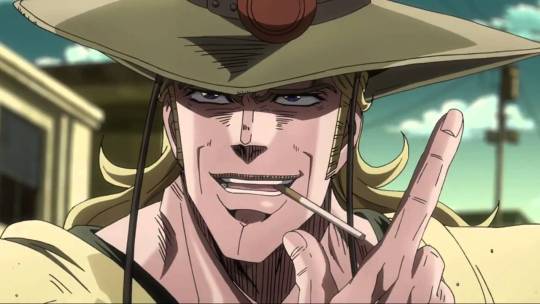
(WARNING! This analysis contains SPOILERS!)
So last year I thought it was a good idea to try and review all of the enemy Stand users in Stardust Crusaders in a totally random order. The results were… mixed. Some of them I think came out okay, but others? Not so much. One of them was just an entire backhanded attack against some guy who decided to say “No one likes your analyses” because I think ProJared was a creep. It was, quite frankly, a mess, and I never bothered to revisit it and never thought I would, even though I still hadn’t covered the glorious, wonderful human being who is Hol Horse.
Well, now, after playing Heritage for the Future and All-Star Battle as well as just becoming a bit more knowledgeable on JJBA, I’ve decided to not only give Hol Horse his dues, but also at least briefly go back over or cover the other Stand users and give them a rating or an updated rating, as the case may be. So buckle in, this is gonna be a long one, and it’s all gonna start with everyone’s favorite incompetent henchman.
Hol Horse is probably one of the most amazing characters Araki has ever created. Hol Horse is in possession of a powerful Stand, The Emperor, which is literally a magical gun that fires bullets he can control the trajectory of. By all accounts, Hol Horse should be the single most dangerous foe that the Crusaders face, more than even Vanilla Ice. This guy should be able to shoot them all dead without a second thought! There’s just one tiny little caveat:
Hol Horse is a fucking moron.
This man is cowardly, incompetent, and just the punching bag of cruel misfortune as all his plans constantly go awry and he is constantly knocked on his ass. And yet, Hol Horse is still the most beloved enemy Stand User of Stardust Crusaders, and it’s not hard to see why. Because despite all of his bumbling, Hol Horse just oozes a sort of cool you just don’t see every day.
(For best results, listen to this the whole time while reading the following).
Motivation/Goals: Hol Horse is one of the few henchmen of DIO who is motivated purely by his own greed… at least, at first. Eventually he has his ass handed to him one too many times, and he decides to try and assassinate DIO. This goes about as well as you’d expect, and Hol Horse – not just part of it, the ENTIRE Horse – is so scared out of his mind that he decides, yep, loyalty to DIO is the way to go! It doesn’t work out, but hey, he tried, right?
Performance: Imami Williams gives Hol Horse that raspy, American charm he needs in the anime adaptation. With his voice and the animation combined, we get to see our favorite smarmy sharpshooter who can’t shoot for shit shoot his shot and miss every time, and it is simply glorious.
Final Fate: Hol Horse kidnaps Boingo and forces him to work with him to finally get his revenge! With the prophetic skills of Thoth and the raw damage that can be done with Emperor, there’s no way they could lose! And yet, as is always the case with Thoth, things go horrendously awry and Hol Horse, despite having the ability to control the trajectory of his bullets, ends up shooting himself and knocking him out of part 3 for good.
Best Scene: Really, just the entirety of the episodes where he teams up with Boingo, especially when he tries holding up Polnareff. Considering what comes after and what came before it, it’s just the dose of lighthearted fun needed before you watch all of your favorite characters get brutally murdered by DIO and Vanilla Ice,.
Best Quote: There is only one line it could be, and it’s Hol Horse’s response to Thoth’s suggestion he kick a woman in the neck: “Listen, Boingo... I am the nicest man in the world. I have girlfriends everywhere. I might lie to a woman, but I'll never hit them! It doesn't matter how ugly they are! Because I respect women!”
That’s right, everyone. Hol Horse drinks Respect Women Juice.
Final Thoughts & Score: Hol Horse is simply astounding. The character is such a colossal screwup that he shouldn’t be as good as he is… yet he is. The dude is gifted with the most incredible power imaginable, and yet somehow he is never able to do a goddamn thing with that power! You control where the bullets go, dude! How can you not hit anything?! It’s interesting how his cowardice and lack of motivation makes him a perfect representation of the inverted Emperor tarot card, but hey, tarot motifs are par for the course with the Stand users.
But there’s something charming to how pathetic Hol Horse is. He’s always plying second banana, he’s a dirty coward who turns tail and runs when things aren’t looking good for him, he never wins a single battle, he didn’t even kill the one guy it seemed like he killed… but throughout it all he still has this sort of smarmy charisma to him that makes him impossible to hate. It’s no wonder this guy has girls all over the world, because he is a world-class charmer. There’s also how Hol Horse is just a character who really, really lives by his own personal philosophy – that is to say, he always likes to be #2, never going into a fight without backup. It’s kind of refreshing to see him always stick by this, even to his own detriment; it’s hard to hate a man who’s principled to that degree. And, of course, this man respects women. Good on him.
It helps that Hol Horse’s inexplicable popularity has led to him getting his time to shine in outside media. Heritage for the Future has two versions of him, his regular form and one that partners him with Boingo, and in skilled hands his Emperor finally gets to live up to its deadly potential. And he’s no slouch in his return appearance in All-Star Battle, and what’s more impressive is in that game he is part of the base roster while Joseph and Iggy, two of the main heroes, are relegated to DLC! You heard me right: the bumbling cowboy who did not win a single fight or even come close to it and spent a lot of time shooting himself managed to beat out out two iconic heroes from the same part onto the roster! Horsey Man must be doing something right.
As this video shows, Hol Horse is one of the most influential characters in the JJBA franchise, having helped to shape the franchise going forward and helped to inspire the traits that made beloved characters like Guido Mista, Gyro Zeppeli, and Yoshikage Kira as legendary as they are. Hell, Hol Horse is just so awesome he almost got to be a protagonist, but Araki decided that Horsey was too similar to my favorite big-titty Frenchman, Polnareff. This means Hol Horse never got his time to shine as a hero, and so stayed a villain til the end… but hey, can he really be that sad if he gets a 10/10 on Psycho Analysis?
Actually, maybe he wouldn’t like that. He likes to play second fiddle to others, after all. But I guess that’s just the curse with these JoJo villains who want to not stand out; they always end up being the best and most memorable characters.
Anyway, now that we’ve got the best of the best out of the way, it’s time for...
Psycho Analysis: DIO’s Other Henchmen
I’m just gonna give my brief thoughts on these guys. Most of them are pretty one-note oneshots, but there are a few who rise above that and manage to be something else entirely. These guys were a learning experience for Araki, and his enemy Stand users of the week definitely improved with later parts, with Vento Aureo really cranking it up to 11.
But for now, we’re stuck with these guys.
Gray Fly: I actually stand by my opinion from my original review of him; he’s nothing incredibly memorable, but he’s a solid start to the adventure and he is directly responsible for diverting the journey onto the course it ended up going on. Without him, things would have likely played out far differently. A 5/10 is still a good score for him.
Fake Captain Tenille: He actually gets bumped down to a 2/10, due to my changes in how things are scored. He’s not amusing enough to be in the “So bad it’s good” category of the other 3s, he’s just really lame and forgettable, and he still somehow manages to lose when he has the advantage. What a dweeb.
Forever: If you think the monkey boat fight is dropping in score, you’re mistaken. Forever remains at an 8/10 for being such a delightfully weird curveball that helps set the tone for the franchise to follow.
Devo: One of the weirder playable character choices from Heritage for the Future, and certainly not one I like too much; he’s also a random event that is pretty useful in All-Star Battle’s online campaign, so that’s a good mark for him. If nothing else, he gave a good showing of Polnareff’s skills when under pressure, so… yeah. I think a 5/10 is good enough.

Rubber Soul: This review I regret because I was backhandedly responding to that guy who weirdly decided to bring up my distaste for ProJared in a review of Arabia Fats and Kenny G. I do mostly stand by what I said; Rubber Soul is one of the more amusing minor foes, if only because of his ridiculous performance as Kakyoin. Still, it really sucks he was just a clone character in Heritage for the Future… put he gets points for having the iconic cherry-licking as a taunt. 6/10 is where he remains.

J. Geil: Again, my opinion hasn’t changed: J. Geil is a mountain of wasted potential, but at the very least he makes for a good antagonist for his brief appearance and hey, he’s the one who helped bring us the beautiful hunk of man that is Hol Horse, so I’d feel bad giving him less than a 7/10.

Nena: I honestly think Nena is one of the most boring Stand users of the part, which is sad because her episode gives Joseph the spotlight. She’s just really gross and uninteresting, and you’ll likely forget her after her episode is over. 2/10.
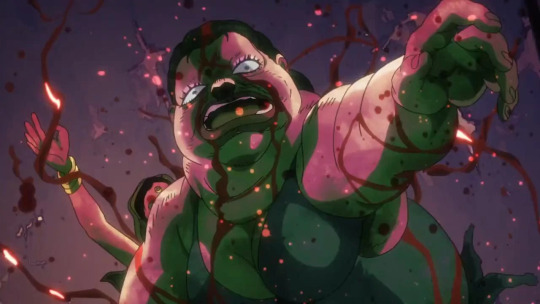
ZZ: ZZ is not particularly great, and his design is just there to be a joke, but it’s hard to totally hate a guy who manages to roll references to Christine, Duel, and the album cover for Eliminator by his namesake into one. I think he’s more of a 4/10, but probably on the higher end there. He’s not great, but he has enough going for him to keep me from hating him.
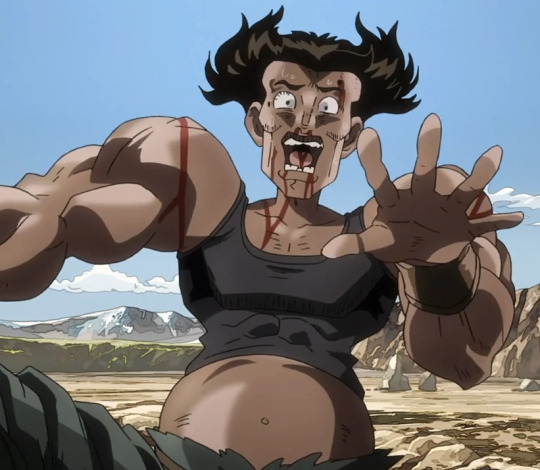
Enya: So if I thought that J. Geil was a waste of potential, I feel this even more so for his mother Enya. Despite being hyped up as this big, intimidating right-hand woman to DIO early on, she gets one appearance where her Stand is defeated by Star Platinum pulling a power out his ass and then is unceremoniously killed by Steely Dan of all people. I will give her this: her interactions with Polnareff are absolutely hilarious. But when all you have going for is some jokes, don’t be surprised when you end up with a 6/10, which you’re pretty much only getting because even despite the mountains of wasted potential you’re really not that bad.
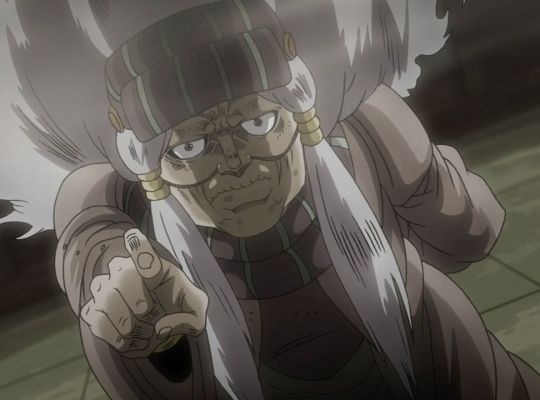
She do be looking hot in the OVA tho.

Steely Dan: My opinion is unchanged; he’s a solid 7/10 oneshot douchebag. Nothing more, nothing less. His level in the PS1 game seriously blows, though.
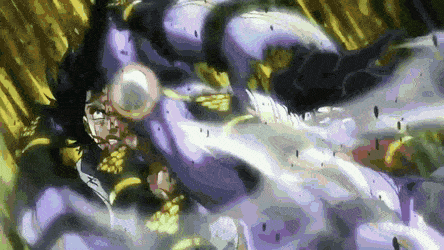
Arabia Fats: I was too hard on this guy. While I meant everything I said, and his episode is boring filler, does it really make him a bottom of the barrel all-time worst villain? No. It just makes him a crappy joke character. 2/10.
Mannish Boy: I regret not getting to this guy last time, because aside from Forever he’s probably one of the most insane Stand user of the part, seeing as he is an infant. Like, he’s just an evil baby who can kill people in their dreams. And he gets defeated by being force fed his own crap. Much like Forever, it’s fun to speculate where exactly DIO found this guy; did he just go to a nursery and start jabbing babies with the Stand arrow? Did he meet this guy at a Cairo night club? What exactly is Mannish Boy’s origin? He’s just so utterly and hilariously inexplicable. He’s definitely a 7/10; he doesn’t quite have the shock factor that Forever did before him, but let’s not pretend an evil talking baby Stand user isn’t one hell of a weird twist.
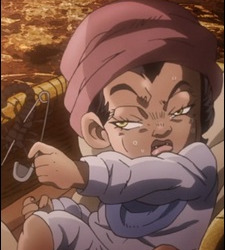
Cameo: This guy really lives up to his name; his Stand is the one that gets the most screentime, with the actual Stand user being relegated to a – you guessed it – cameo appearance at the end of the fight. Thankfully, his Stand is an enjoyable take on jerkass genies and gives a pretty sad and disturbing episode that not only features my man Polnareff, but also marks the point where Avdol returns and brings “Hell 2 U!” I think he deserves at least a 7/10, even if this is mainly for Judgment. Still, a Stand is a representation of the user’s soul, so I think it works out.
Here’s the Stand:

And here’s the man behind it:

Midler: Midler is one of the single most interesting characters from the pre-Egypt half of Stardust Crusaders, and is the point where Stand users really started to get interesting. Her Stand, High Priestess, has a really funky and unique design, and her battle serves as the final roadblock before the Crusaders arrive in Egypt. Despite never appearing onscreen, with only her unconscious body being shown at the end of the fight in a way that obscures her, she got to appear in Heritage for the Future with an awesome sexy belly dancer design and a badass moveset that makes her a really fun character to play as. Taking everything into account, I think she just barely scrapes into the bottom of the 8/10 pool, though really this is mainly for her playable appearance.

N’Doul: My opinions really haven’t changed on him. He’s still an 8/10.
Oingo & Boingo: These guys are, in a word, hilarious. In between the grueling, brutal fight with N’Doul and the later fights in the part, these guys bring some much needed levity to the proceedings. Oingo gets an entire episode where he just completely bumbles about as he attempts to impersonate Jotaro to assassinate the Crusaders, failing at every turn and only managing to blow himself up in the end. Boingo fares a little better, eventually getting roped in to Hol Horse’s scheme to get some revenge, which leads to one of the funniest episodes of the entire series as Hol Horse and Oingo hold up Polnareff. I think they collectively get an 8/10 for being two of the funniest Stand users in the part. They even get their own unique end credits in the anime (with Hol Horse joining in on the fun when he teams up with Boingo)!
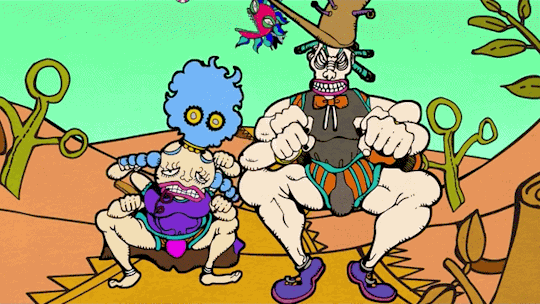
Anubis: Again, my opinion is unchanged, though I must say him having technically three playable appearances in Heritage for the Future does make me have at least a little more fondness for him. Black Polnareff, Chaka, and Khan are all amusing characters to play as and all have some awesome theme music. Introducing the concept of Stands being able to exist independently of their Original user is pretty neat, as well as the idea of a Stand that can switch users like it does. 7/10 is still what I’d give it, but I think that it’s pretty telling that this is probably the “weakest” character in the Egypt arcs in terms of being a villain, and yet he’s still pretty cool.

Mariah: Completely unchanged. She still deserves an 8/10, because her episode is hilarious, her playable appearance in Heritage for the Future is a blast, and she’s just really frikkin’ hot. I’m not gonna lie, she’s probably my second favorite enemy Stand user out of the Egyptian ones. I may or may not want her to step on me.
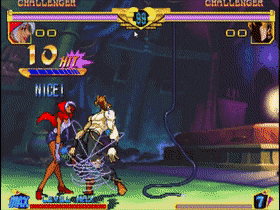
Alessi: I’m going to be honest here: Alessi is my favorite of the Egyptian Stand users. He’s an ax crazy coward with pedophile undertones who is just an utterly demented and sick individual with a seriously intriguing Stand that de-ages its victims. It’s a damn shame he never crossed paths with Joseph and de-aged him, but when he’s just such a hilarious and hateable lunatic with an incredibly fun playable appearance in Heritage for the Future (complete with awesomely creepy theme music!) it’s hard for me to give Alessi anything less than a 9/10. Attaboy!

Daniel J. D’Arby: My opinion is honestly unchanged, but I think I’d bump him down to an 8/10.
Pet Shop: Again, unchanged really. It’s hard to give a character as busted as he is in Heritage for the Future anything less than a 9/10 any way you slice it.
Telence T. D’Arby: Opinion unchanged, 8/10. I don’t have much else to say here, besides Xander Mobus rocks.
Kenny G: See Arabia Fats above. I got irrationally mad over a dumb joke character. He’s not going above a 2/10, but he’s not worth really getting mad about.
Vanilla Ice: I still think he’s the only enemy Stand user besides Hol Horse who deserves his 10/10. My opinion of him remains unchanged, but I would like to say he’s easily one of my favorite characters to play as in All-Star Battle.
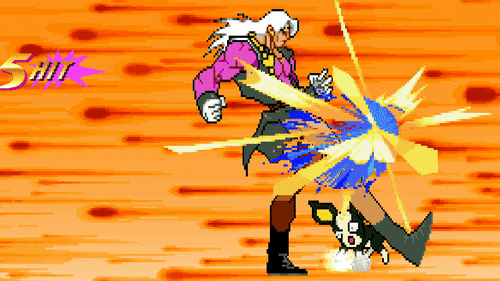
Nukesaku: Ok, he’s not an enemy Stand user, he’s just some weird vampire… zombie… thing. Still, I feel he’s at least worth briefly mentioning, if only because he’s probably the only easily-defeated joke villain Araki did from the first three parts who is particularly memorable. Wired Beck and Doobie are really not all that memorable, but Nukesaku at least elicits a few chuckles – he even gets cameos in Heritage for the Future as well as getting to be a stage hazard in All-Star Battle. For what he is, I think he deserves a 5/10.
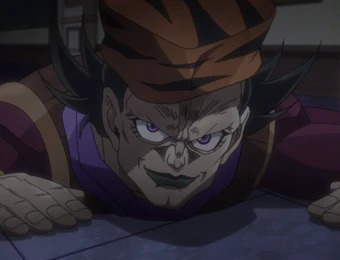
And with all these enemies taken care of, that just leaves one more Stand user to talk about.. one whose Psycho Analysis has been sitting in my drafts for a year now...

40 notes
·
View notes
Text
“Oceanic Wooziness” and the Wire Top 50
Joseph Stannard coined this neat summation, in his review of a live performance at Cafe Oto, in this month’s Wire magazine, by the winner of it’s ‘Releases of the Year’ annual list, Fatigue, by the Brooklyn songwriter L’Rain. And I’m afraid that ‘fatigued’ is exactly how I felt when going through their Top 50 of 2021. I was reminded, with Stannard’s description, of so many of the bands valorised by Simon Reynolds in his very first book Blissed Out (1990), with ‘oceanic rock’ being a ‘thing’ that he continued to describe in his next book, Sex Revolts, co-authored with his missus, Joy Press. Is this now the ‘happening’ sound of 30 years later?
2021 is the first year that, since first reading (The) Wire in 1985, that I have absolutely NONE of the albums that the magazine’s writers have put forward as being the year’s best. Always a questionable proposition, Wire ‘best of’ lists have always generally resonated with my own listening habits until now. It must be my age, but I don’t find much of the current list to be of especial interest or of a genuinely challenging nature. L’Rain seems to be singing ‘electronic torch songs for the Cafe Oto crowd auditioning for a David Lynch movie’, and current Wire fave, Moor Mother, is also described as “woozy” in John Morrison’s review of her number two album, Black Encyclopedia of the Air. Is this a sign of our Covid times, I wonder?. L’Rain’s album curiously reminds me of a former Wire number one, Lauren Halo’s (an appropriate surname?) debut from 2012, Quarantine (a prescient title). Hip syncretism seems the order of the day. For example, Promises, at number 3 in the chart, combines good old Pharoah Sanders with the even more venerable London Symphony Orchestra (memories of it’s 1969 work with Deep Purple, Concerto for Group & Orchestra, unfortunately raise their ugly heads at this point), and with an electonica ‘name’ Floating Points, to produce an underwhelming piece of Hip Easy Listening.
It’s the same old, same old, really: another Low album at number 4, with the duo’s very 90s combination of “vulnerable and intimate vocal harmonies with overdriven guitar roar...”, straight out of MBV and Flying Saucer Attack; a 12-hour Anthony Braxton exhaust-athon (his prolixity is becoming more and more jaw-dropping), similarly, William Parker drops in his 10 CD box set, with its equally weighty title, Migration of Silence Into and Out of the Tone World , for our consideration; a four-CD John Cage set: more retro-futurism from the Sons of Kemet (tuba-driven, and with Shabaka’s stuttering staccato sax on top, they always give value for money) and bleak contemporary analyses of our woes and weals from Moor Mother (a couple of releases) and The Bug (Kevin Martin’s lack of a sense of humour is becoming increasingly deadening)..
I know this must sound miserabilist, and it’s almost certainly my mood (we’re in lockdown with Covid for 10 days), but, more positively, the album that has bought me the most joy recently is Can’s Live in Stuttgart 1975. It’s ironic that Miles Davis retired from public performance in this very year because I can hear his contemporary group(s) all over this album, a stew of extended electro-funkified rock. (Furthermore, in terms of “oceanic wooziness”, can any act ever beat In a Silent Way?) For a year that is generally considered a pre-punk nadir, 1975 can still unearth material that ultimately put the more lionised 1977 in the shade. Consisting mostly of improvised material using themes from Future Days and Soon Over Babaluma (whatever Julian Cope says, these are surely their most timeless albums?), these 90 minutes still excite and keep one guessing. (”Jaki’s good tonight, innee?”, to paraphrase Jagger).
BEST WISHES FOR A GOOD XMAS TO YOU ALL.
1 note
·
View note
Text
CMS 316
An essay comparing and contrasting Hip-Hop and Rock including the origins of the genres.
Hip-Hop Value
There is this connotation or connection between HipHop and Black people, as stereotypical as that may be. Most black families especially in the United States grew up listening to Hip-hop or RnB. Hip-Hop serves as a cultural expression of socially and economically marginalized African-Americans. Before Hip-Hop and rap expanded commercially, the songs in both genres focused on the community and lives of the artists. Many rappers in the 1970s and beyond presented the troubles of being black and poor while suffering white control and power. Let us digress, as we learned in class. Jamaican music, for example, reggaeton was a genre of music that was introduced in a very interesting way by the use of sound systems. It became a competition in the island amongst others, and it was a way where young people listened and grew accustomed to a genre that was being born and developed, a genre that came to fruition. This may serve as a background to my previous statement in which black families would play music of their forefathers and greats that played music during their era or the previous one. Most artists nowadays point out how influential their parents were to their artistry, playing certain types of music. In 2018, Hip Hop and R&B became the biggest music genre in the United States and was the big break African-Americans had been waiting for. With the technology that is in place at this moment, it has propelled the consumption and commercialization of music.
The Pulitzer Prize
Another major achievement in Hip-Hop was Kendrick Lamar winning the Pulitzer Prize. It was a momentous and historic occasion for Hip-Hop. The win added value to the category and went further to define the authenticity of this category of music. The Pulitzer prize impacts significantly on American journalism, photography, writing, and music. Incidentally many upcoming journalists, writers, and musicians dream of ever bagging this highly esteemed and prestigious prize established in 1917. Pulitzer Prize defines any of a series of annual prizes awarded by Columbia University, New York City, for excellent public service and achievement in American journalism, letters, and music. The prize that is also endowed with a substantial amount of $ 500,000 as a gift from the newspaper magnate Joseph Pulitzer and has been awarded since 1917. The Pulitzer Prize Board comprises of judges appointed by Columbia University. Kendrick Lamar became the first non-classical or jazz winner of the Pulitzer Prize for music. “They gave an “additional citation” to Bob Dylan in 2008, and to Hank Williams in 2010– a mere 57 years after the latter’s death – but the prize itself has remained almost exclusively the domain of classical music. In its history, there have only been three jazz winners: Wynton Marsalis in 1997, Ornette Coleman in 2006, and Henry Threadgill in 2016.” (The Guardian)
Marc Bamuthi Joseph is a spoken-word poet, dancer, and playwright who frequently directs stand-alone hip-hop theater plays. In an interview conducted by Philip Bither, Senior Curator, Performing Arts, Walker Art Center, via skype. He asked what Hip Hop means to Joseph as an artist, and he retorted by saying, “In the way the Civil Rights era, or the Vietnam War, or any number of climatic global or localized cultural events have shaped the ideology and aesthetics and morals and morale of folks born at those times, I was born in the same place at the same time that hip-hop culture was born, I was born in a time of AIDS, born in a period of Reaganomics. Hip-hop music and aesthetics formed the soundtrack for all things for me. My political consciousness was formed through hip-hop music and hip-hop culture, through the work of Chuck D and Public Enemy, KRS-One and Boogie Down Productions. They gave me vocabulary to articulate political positions and language to locate myself socio-economically. I think about hip-hop culture not only in terms of its aesthetic manifestations, not only in terms of B-boying or MC-ing or DJ-ing or graffiti, I think about energetic reciprocity. I think about ritual and (in)visibility. I think about the idea of the break and sampling and style. These are my antecedents.” This gives new perspective to what was previously said. Not only is Hip-Hop all about music. There is a deeper meaning, in a time of racial injustice and political and economical unfairness towards the black community. Hip-Hop music was right there to write the message, in a lyrical and explicit way. For example, the N.W.A (Niggaz with Attitude) were an American hip-hop group from Los Angeles, California. They were active from 1986 to 1991 and the rap group was plagued with controversy for their explicit lyrics, misogynistic and romanticising drug use and crime. The group was vocal about their experiences of racism and uncontrolled policing. Generally speaking, rap music serves as an expressive artistic outlet for a marginalized and demonized urban social bloc that speaks with heavily black and latino, predominantly masculine accents within a staunchly white and patriarchal social order (C. H. Smith 1995). Additionally, the group was political and their music revolved around political issues happening in the country during that time (Wikipedia). The group is considered one of the greatest and most influential groups in the history of hip-hop music. The unapologetic violent, and sexist veterans of gangsta rap remain the most infamous group in history. It is important to note that gangsta rap harnessed itself as the most popular form of hip-hop and the group also rewrote the rules of the category during the 1990’s. NWA established a cultural resurgence that led to the mainstream recognition of their cultivated legacy in the history of rap and hip-hop that culminated to their induction into the rock and roll hall of fame in 2016.
Hip-Hop’s authenticity and credibility
Authenticity and the hip-hop genre has been linked since the late 1970s. With debut albums from Beanie Sigel with the bold album name “The Truth”, or Nas’s most famous song, “Last Real Nigga Alive.” These songs titles alone encapsulate what hip-hop is and its identity as an authentic piece of expression. Magazines such as The Source played an important role in dedicating their newsletter to “true hip-hop.” The source is a full-color magazine based in the United States that covers hip-hop music, politics and culture and was founded in 1968. It is the world’s longest running rap periodical. However, as we have learned in class, the music industry will always find and commercialize a genre that is seemingly on the rise. This has further ruined the credibility of hip-hop’s “realness.” Rapper Murs saw this happening, and in 2004 in his song, And This is For, he raps, “Used to feel I should be silent, I was scared to do this song/But I want everyone aware of what is going on/Yes it is jazz and yes it is the blues/And yes it is the exact same way they did rock/But I refuse to watch the same thing happen to hip-hop/I refuse to watch that bullshit.” Hip-hop, like any genre of music that is explicit towards the culture such as punk, and American folk music, finds itself in the mainstream where MC’s try to attempt to draw a line of authenticity by distinguishing it around their culture. The issue of authenticity is a difficult matter to tackle within the hip-hop genre. Some MC’s believe it is the realness of lyrics and remaining true to oneself. Others may also believe that it is not acceptable to the mainstream or encouraging hypermasculinity, which is a problem in the African American community, but let us digress. Another theory of authenticity in hip-hop is the capacity of knowledge and history by an MC where he/she could wield that understanding and become an authentic character in the genre. President Kennedy had this to say about hip-hop’s history, “is like taillights on a boat which illuminates where we have been when we should be focusing on where we should be going.”
Rock credibility, authenticity, and value
Equally important is rock. Rock is described to be the first “oppositional” form of expression to be pushed into mainstream consumption. Rock culture has prevailed since the 1960s, and the rock genre has undergone different forms to what can be studied today. During its different augmentation, rock music has remained to be an expression of the youth. During the 1960s, rock has been a mode of declaration for political statements and of course romantic relationships. This is where comparison with Hip-Hop draws close. Also, the genre uses satire as irony to criticize the culture. There’s a question of authenticity that resides in pop music or rock music, and this further deviates into marginalizing rock music in itself. The use of authenticity to analyze the differentiation between rock identifies itself and separates itself from popular or mainstream music. There is a residual spoken language between recording and live performances. Live performances aid in considering an authentic rocker; furthermore, in following a traditional path. Musicians have to initiate connection and conversation through live performances. In the same conversation, we must acknowledge that there are two different types of authenticity in recognizing rock ethos. Modernist and Romantic. The modernist approach constitutes of tradition and continuity with the past roots, sense of community, populism, belief in a core or essential rock sound, liveness. The romantic approach is as follows: avant gardes, status of the artist, elitism, openness regarding rock, record-ness, and celebrating technology. This is important to understand because elitists do not hold any ground in influencing rock culture. As opposed to Hip-Hop, where being real is hailed with honor. However, if we are to analyze the hip-hop scenario in the present day, avant-gardes could be denounced as infectious to the hip-hop community. Regardless, traditional MCs do have a huge following, because they follow a more romantic approach. The 1960s youth demographic brewed the existence of rock to be pushed and consumed within mainstream music. While rock music expresses modernity and romance, hip-hop is validly not just a type of music but also a culture. It is a by-product of culture. People embedded in this culture are associated with musical practices such as rapping, Djing, beatboxing, freestyling, and looping. Early hip-hop music embed man-made beats, turntables, and vocals while the lyrics were often in rhythmic spoken format. Dancing was an essential part of this genre. However, hip-hop has evolved to the luxurious music embedded with technology, computerized beat machines, synthesizers, and digital beat and rhythm equipment. Conversely, rock is one of the oldest forms of music in mainstream today. The modern rock genre has roots in Rock n’ roll of the 1940s. Rock is an instrument based music with total reliance on guitar’s beat and rhythm. The utilization of bass guitar and drums is often evident. Rock possesses many sub-tribes like blues, jazz, funk, and glam. While hip-hop is hinged on origins that are expressly political, societal, and social, rock registers its origins with the creation of rhythm and melodies produced by instruments. It is important to note rock is older than hip-hop and while hip-hop was not instrument-oriented, rock adapted to instruments at inception. While African –Americans were the major agents and originators of hip-hop. Caucasians and white Americans were and still remain the promoters of rock. While hip-hop continues to be hardwired by rhythmic sounds of speech, rock is embedded with the guitar’s rhythms. While hip-hop music originates and has maintained its presence only in the United States of America, rock transcended to other countries such as the United Kingdom and Australia. Both positive and negative influences of hip-hop are acknowledged. It is recognized that early hip-hop helped minimize inner-city gang violence by replacing physical violence with dance and artwork battles. Hip-hop has contributed abundantly to our economic wellbeing and represents a multi-billion dollar industry that impacts on many aspects of life, such as the automotive design and fashion, prime time television programming, college and professional sports, mass media marketing (Centre for Mental Health in Schools).
0 notes